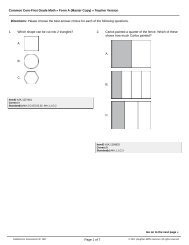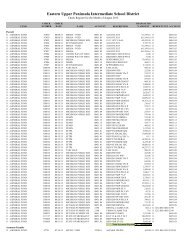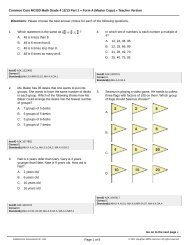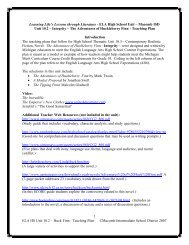- Page 1 and 2:
Teaching Algebra with Manipulatives
- Page 3 and 4:
Contents Easy-to-Make Manipulatives
- Page 5:
Algebra 1 Activities Page 14-5 Alge
- Page 8 and 9:
Glencoe Mathematics Manipulatives G
- Page 10 and 11:
Centimeter Grid Paper © Glencoe/Mc
- Page 12 and 13:
Coordinate Planes © Glencoe/McGraw
- Page 14 and 15:
Coordinate Planes for Trigonometric
- Page 16 and 17:
Conic Graph Paper (circles and line
- Page 18 and 19:
Algebra Tiles (units) 1 1 1 1 1 1 1
- Page 20 and 21:
Integer Models Summary There are tw
- Page 22 and 23:
Equation Models Summary A zero pair
- Page 24 and 25:
Equation Mat © Glencoe/McGraw-Hill
- Page 26 and 27:
Rectangular Dot Paper © Glencoe/Mc
- Page 28 and 29:
Problem Solving Guide Problem: Expl
- Page 30 and 31:
Die Patterns Cut along the heavy bl
- Page 32 and 33: © Glencoe/McGraw-Hill 24 Teaching
- Page 35 and 36: Chapter 1 Mini-Project Evaluating E
- Page 37 and 38: Chapter 1 Teaching Notes and Overvi
- Page 39 and 40: Using Overhead Manipulatives (Use w
- Page 41 and 42: The Distributive Property Materials
- Page 43 and 44: Investigating Real-World Functions
- Page 45 and 46: Chapter 2 Teaching Notes and Overvi
- Page 47 and 48: NAME ______________________________
- Page 49 and 50: Using Overhead Manipulatives • Re
- Page 51 and 52: NAME ______________________________
- Page 53 and 54: Using Overhead Manipulatives (Use w
- Page 55 and 56: Using Overhead Manipulatives • Ha
- Page 57 and 58: NAME ______________________________
- Page 59 and 60: Chapter 3 Teaching Notes and Overvi
- Page 61 and 62: Chapter 3 Teaching Notes and Overvi
- Page 63 and 64: Chapter 3 Teaching Notes and Overvi
- Page 65 and 66: Formulas NAME _____________________
- Page 67 and 68: NAME ______________________________
- Page 69 and 70: Using Overhead Manipulatives Demons
- Page 71 and 72: Using Overhead Manipulatives (Use w
- Page 73 and 74: Using Logic NAME __________________
- Page 75 and 76: Using Overhead Manipulatives Demons
- Page 77 and 78: Using Overhead Manipulatives (Use w
- Page 79 and 80: NAME ______________________________
- Page 81: Using Overhead Manipulatives (Use w
- Page 85 and 86: Using Overhead Manipulatives (Use w
- Page 87 and 88: NAME ______________________________
- Page 89 and 90: NAME ______________________________
- Page 91 and 92: Chapter 4 Teaching Notes and Overvi
- Page 93 and 94: Using Overhead Manipulatives (Use w
- Page 95 and 96: Using Overhead Manipulatives (Use w
- Page 97 and 98: NAME ______________________________
- Page 99 and 100: NAME ______________________________
- Page 101 and 102: Chapter 5 Using Overhead Manipulati
- Page 103 and 104: Chapter 5 Teaching Notes and Overvi
- Page 105 and 106: Demonstration 2 Finding Slope: Zero
- Page 107 and 108: Using Overhead Manipulatives (Use w
- Page 109 and 110: Demonstration 2 Writing an Equation
- Page 111 and 112: NAME ______________________________
- Page 113 and 114: Making Predictions Materials: NAME
- Page 115 and 116: 23 22 21 20 NAME __________________
- Page 117 and 118: Chapter 6 Teaching Notes and Overvi
- Page 119 and 120: Using Overhead Manipulatives (Use w
- Page 121 and 122: Using Overhead Manipulatives Demons
- Page 123 and 124: NAME ______________________________
- Page 125 and 126: Compound Inequalities (Continued) 1
- Page 127 and 128: Absolute Value NAME _______________
- Page 129 and 130: Using Overhead Manipulatives Demons
- Page 131 and 132: Chapter 7 Teaching Notes and Overvi
- Page 133 and 134:
NAME ______________________________
- Page 135 and 136:
NAME ______________________________
- Page 137 and 138:
Chapter 8 Polynomials Teaching Note
- Page 139 and 140:
Chapter 8 Teaching Notes and Overvi
- Page 141 and 142:
Chapter 8 Teaching Notes and Overvi
- Page 143 and 144:
NAME ______________________________
- Page 145 and 146:
NAME ______________________________
- Page 147 and 148:
Using Overhead Manipulatives Demons
- Page 149 and 150:
NAME ______________________________
- Page 151 and 152:
Using Overhead Manipulatives Demons
- Page 153 and 154:
Using Overhead Manipulatives (Use w
- Page 155 and 156:
NAME ______________________________
- Page 157 and 158:
Using Overhead Manipulatives (Use w
- Page 159 and 160:
Using Overhead Manipulatives Demons
- Page 161 and 162:
Chapter 9 Teaching Notes and Overvi
- Page 163 and 164:
Chapter 9 Teaching Notes and Overvi
- Page 165 and 166:
Using Overhead Manipulatives (Use w
- Page 167 and 168:
Factoring Trinomials Materials: NAM
- Page 169 and 170:
Using Overhead Manipulatives Demons
- Page 171 and 172:
Factoring Trinomials x NAME _______
- Page 173 and 174:
Using Overhead Manipulatives (Use w
- Page 175 and 176:
Difference of Squares Materials: NA
- Page 177 and 178:
Demonstration 2 Factoring 4x 2 4x
- Page 179 and 180:
Factoring Trinomial Squares Figure
- Page 181 and 182:
Chapter 10 Quadratic and Exponentia
- Page 183 and 184:
Chapter 10 Teaching Notes and Overv
- Page 185 and 186:
NAME ______________________________
- Page 187 and 188:
Using Overhead Manipulatives • Ar
- Page 189 and 190:
NAME ______________________________
- Page 191 and 192:
Chapter 11 Radical Expressions and
- Page 193 and 194:
NAME ______________________________
- Page 195 and 196:
NAME ______________________________
- Page 197 and 198:
Using Overhead Manipulatives (Use w
- Page 199 and 200:
NAME ______________________________
- Page 201 and 202:
Chapter 12 Rational Expressions and
- Page 203 and 204:
Using Overhead Manipulatives (Use w
- Page 205 and 206:
NAME ______________________________
- Page 207 and 208:
Chapter 13 Statistics Teaching Note
- Page 209 and 210:
Analyze the Data 1. Cut out the gra
- Page 211 and 212:
Investigating Percentiles Materials
- Page 213 and 214:
Chapter 14 Teaching Notes and Overv
- Page 215 and 216:
NAME ______________________________
- Page 217 and 218:
Simulations NAME __________________
- Page 219 and 220:
Chapter 1 Teaching Notes and Overvi
- Page 221 and 222:
Investigating Polygons and Patterns
- Page 223 and 224:
NAME ______________________________
- Page 225 and 226:
Chapter 2 Linear Relations and Func
- Page 227 and 228:
NAME ______________________________
- Page 229 and 230:
Chapter 3 Teaching Notes and Overvi
- Page 231 and 232:
NAME ______________________________
- Page 233 and 234:
NAME ______________________________
- Page 235 and 236:
NAME ______________________________
- Page 237 and 238:
NAME ______________________________
- Page 239 and 240:
NAME ______________________________
- Page 241 and 242:
Chapter 5 Teaching Notes and Overvi
- Page 243 and 244:
Factoring Trinomials Materials: NAM
- Page 245 and 246:
NAME ______________________________
- Page 247 and 248:
NAME ______________________________
- Page 249 and 250:
Chapter 6 Quadratic Functions and I
- Page 251 and 252:
NAME ______________________________
- Page 253 and 254:
NAME ______________________________
- Page 255 and 256:
NAME ______________________________
- Page 257 and 258:
Chapter 7 Polynomial Functions Teac
- Page 259 and 260:
Chapter 7 Teaching Notes and Overvi
- Page 261 and 262:
NAME ______________________________
- Page 263 and 264:
Algebra Activity Draw Graph each fu
- Page 265 and 266:
NAME ______________________________
- Page 267 and 268:
Chapter 8 Conic Sections Teaching N
- Page 269 and 270:
Chapter 8 Teaching Notes and Overvi
- Page 271 and 272:
NAME ______________________________
- Page 273 and 274:
Conics NAME _______________________
- Page 275 and 276:
Locating Foci NAME ________________
- Page 277 and 278:
Conic Sections NAME _______________
- Page 279 and 280:
Chapter 9 Mini-Project Interpreting
- Page 281 and 282:
Rational Functions Materials: NAME
- Page 283 and 284:
NAME ______________________________
- Page 285 and 286:
NAME ______________________________
- Page 287 and 288:
Chapter 11 Sequences and Series Tea
- Page 289 and 290:
Chapter 11 Teaching Notes and Overv
- Page 291 and 292:
NAME ______________________________
- Page 293 and 294:
NAME ______________________________
- Page 295 and 296:
Algebra Activity Step 5 Step 6 Step
- Page 297 and 298:
Chapter 12 Teaching Notes and Overv
- Page 299 and 300:
Area Diagrams NAME ________________
- Page 301 and 302:
NAME ______________________________
- Page 303 and 304:
Simulations NAME __________________
- Page 305 and 306:
Chapter 13 Trigonometric Functions
- Page 307 and 308:
NAME ______________________________
- Page 309 and 310:
Investigating Regular Polygons Usin
- Page 311 and 312:
Chapter 14 Trigonometric Graphs and







